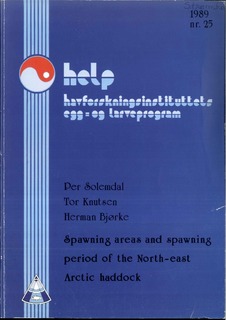| dc.contributor.author | Solemdal, Per | |
| dc.contributor.author | Knutsen, Tor | |
| dc.contributor.author | Bjørke, Herman | |
| dc.date.accessioned | 2010-05-26T11:48:11Z | |
| dc.date.available | 2010-05-26T11:48:11Z | |
| dc.date.issued | 1989 | |
| dc.identifier.uri | http://hdl.handle.net/11250/115257 | |
| dc.description.abstract | Spawning of North-East Artic haddock occurs on the Norwegian continental slope. The location of the spawning grounds is, however, diffuse. This is mainly due to difficulties in identifying haddock eggs. In this work this problem is solved by using the biochemical genetical approach of electrophoresis. The results from haddock egg and trawl surveys in April -May 1987 and 1988 are analysed in relation to previous knowledge of haddock egg distribution and mature fish. Gonad maturity is compared to the distribution of egg developmental stages i n different regions. Both horizontal and vertical gradients in gonad maturity of haddock are revealed. Most of the Tromsøflaket area from Nordkapp to near the shelf edge bordering the Norwegian Sea (Norskehavet) are inhabited by immature haddock. An increase in abundance of mature fish takes place in the western part of the shelf. The main spawning areas of North-East Arctic haddock seems to be the southeastern part of the continental slope of Tromsgflaket at depths from 303 to 600 m and temperatures between 4ºand 6º C. Other spawning areas are found in Vestfjorden and over the continental slope from Tromsøflaket south to Rosttunga. The spawning in Vestfjorden seems to take place a t depths shallower than 200 m, but within the same temperature limits . Spawning seems to start at the beginning of April, reaches its maximum at the end of the month and ends during the first half of May. Very little spawning is recorded on the shelf and the continental slope from Røsttunga to 64º N. Spawning i n the area 62-64º N (Møre) is supposed to origin from a local stock. The onset of this spawning seems to take place a week or two earlier than what was observed further north. A distinct bimodal distribution of larvae sampled in July 1987 indicate a possible influx of haddock larvae to the Norwegian coast which might originate from a population different from the North-East Arctic haddock. | en_US |
| dc.language.iso | eng | en_US |
| dc.publisher | Havforskningsinstituttet | en_US |
| dc.relation.ispartofseries | help;1989 nr. 25 | |
| dc.title | Spawning areas and spawning period of the North-east Arctic haddock [HELP 25} | en_US |
| dc.type | Research report | en_US |
| dc.subject.nsi | VDP::Agriculture and fishery disciplines: 900::Fisheries science: 920::Resource biology: 921 | en_US |
